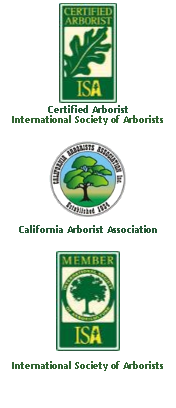
|
Why Hire a Certified Arborist |
|
An arborist is a specialist in the care of individual trees. Arborists are knowledgeable about the needs of trees, and are trained and equipped to provide proper care. Hiring an arborist is a decision that should not be taken lightly. Proper tree care is an investment which can lead to substantial returns. Well cared for trees are attractive and can add considerable value to your property. Poorly maintained trees can be a significant liability. Pruning or removing trees, especially large trees, can be dangerous work. Tree work should only be done by those trained and equipped to work safely in trees. PruningThe arborist can determine what type of pruning is necessary to maintain or improve the health, appearance and safety of your trees. These techniques include: ∑ Eliminating branches that rub each other. ∑ Remove limbs that interfere with wires, building facades, gutters, roofs, chimneys, windows or obstruct streets or sidewalks. ∑ Removing dead or weak limbs that pose a hazard and may lead to decay in the tree if not removed. ∑ Removing diseased or insect infested limbs. ∑ Creating better structure to lessen wind resistance and reduce the potential for storm damage. ∑ Removing limbs damaged by adverse weather conditions. ∑ Thinning or removal of unnecessary branches. ∑ Improving the shape or silhouette of the tree. RemovalAlthough tree removal is a last resort, there are circumstances when it is necessary.† An arborist can help determine whether or not a tree should be removed. Arborists have the skills and equipment to safely and efficiently remove trees. Removal is recommended when: ∑ The tree is dead or dying. ∑ The tree is considered irreparably hazardous. ∑ The tree is causing an obstruction that is impossible to correct through pruning. ∑ The tree is crowding and causing harm to other trees. ∑ The tree is to be replaced by a more suitable specimen. ∑ The tree should be removed to allow for new construction. Emergency Tree Care Storms may cause limbs or entire trees to fail, often landing on homes, cars, other structures or other trees. The weight of storm damaged trees is great and they can be very dangerous to remove or trim. An arborist can assist in performing the job in a safe manner, while reducing further risk of damage to your property. Other ServicesPracticing Plant Health Care; a concept of preventative maintenance to keep trees in good health which will help the tree better defend itself against insects, disease and site problems. ∑ Fertilization and determining nutritional needs of trees. ∑ Cabling or bracing for added support to branches with weak attachment. ∑ Aeration to improve root growth. ∑ Installation of lightning protection systems. ∑ Spraying or injecting to control certain insect and disease problems. Selecting the Right Arborist for the Job Check in the phone directory yellow pages for those arborists who advertise as ISA Certified Arborists or display the official logo of the ISA Certified Arborist. Certified arborists are experienced professionals who have passed an extensive examination covering all aspects of tree care. Ask for proof of insurance and then phone the insurance company if you are not satisfied. A reputable arborist will have personal and property damage insurance as well as workers compensation insurance. Many homeowners have had to pay out large amounts of money for damages caused by an uninsured individual claiming to be a tree expert. You could be held responsible for damages and injuries that occur as a result of the job. Ask for references to find out where the company has done work similar to the work you are requesting.† Donít hesitate to check references or visit other worksites where the company or individual has done tree work. Remember, tree care is a substantial, long-lasting investment; you would not buy a car without a test drive! Unless you know and are comfortable with the arborist, get more than one estimate. You may have to pay for the estimates, and it will take more time, but it will be worth the investment. Be wary of individuals who go door-to-door and offer bargains for performing tree work. Most reputable companies are too occupied to solicit work in this manner. Improper tree care can take many years to correct itself and in some cases never corrects itself. Are you willing to take that risk with your valuable†††††† investment? Good arborists will only perform accepted practices. For example, practices such as topping a tree, removing an excessive amount of live wood, using climbing spikes on trees which are not being removed, and removing or disfiguring living trees without just cause, are unnecessary, except in extremely rare instances. Donít always accept the low bid. You should examined the credentials and the written specification of the firms who submitted bids and determine the best combination of price, work to be done, skill and professionalism to protect your substantial investment. Get it in writing. Most reputable arborists will have their clients sign a contract. Be sure to read the contract carefully. Donít be afraid to ask questions such as --When will the work be started and completed? --Who will be responsible for clean-up? --Is this the total price? --If I would like more to be done, what is your hourly rate? What Is a Certified Arborist? Certified arborists must also continue their education to maintain their certification. Therefore, they should e up-to-date on the latest techniques in arboriculture. Be an Informed Consumer ∑ Benefits of Trees ∑ Tree Selection ∑ Avoiding Tree and Utility Conflicts ∑ New Tree Planting ∑ Plant Health Care ∑ Tree and Turf Relationships ∑ Mature Tree Care ∑ Insect and Disease Problems ∑ Recognizing Tree Hazards. Your local garden center, county extension agent and city arborist are also excellent sources of information if you should have further questions. They may also be able to refer you to certified arborists. Reprint from: Why Hire An Arborist; a brochure created by the International Society of Arboriculture. 1994 International Society of Arboriculture |


|
Serving Marin County for over 35 Years |
|
34 De Luca Place, Suite M San Rafael, CA 94901
|
|
Phone: 415-472-7105 Fax:†††† 415-721-2470
|
